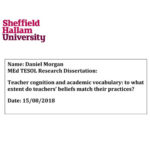Grammar and Beyond 2
Randi Reppen. Cambridge, NY: Cambridge University Press, 2012, Pp. ix + 399.
Reviewed by Sarab Yousif Al-Akraa
University of Central Florida, USA
Teachers who intend to teach the authentic form, meaning and use of English grammar to their ESL students as it occurs in real life should take a look at Randi Reppen’s Grammar and Beyond 2. This book is a series of four books for beginning to advanced level ESL students. All books in the series focus on the grammar structures most commonly used in North America with an emphasis on the application of grammar structures to academic writing. Book 2 of this series is designed for intermediate adult ESL students. Reppen presents grammar points in such a realistic way by using contemporary texts. Additionally, the author connects grammar points to specific application within writing.
The main goal of this book is to draw ELL students’ attention to the structures that are commonly used in written and spoken North American English. The tasks and activities are designed to help students avoid the most common mistakes that English language learners make. For example, each grammar unit has tasks that require students to find and correct the common mistakes made by non-native English speakers. Moreover, the text of each chapter introduces substantial vocabulary from the Academic Word List.
The book is organized in a level-appropriate order in which students can master syntactical rules of the target language. It is recommended that the teacher should follow the same order to increase the students’ knowledge of structure gradually. Grammar and Beyond 2 consists of 32 units. The typical format of the individual unit begins with a demonstration of realistic context illustrating how that unit’s grammar is used in the real world. This demonstration is followed by activities that guide students to analyze the form, meaning, and use of the structure. The second section of each unit presents the grammar point of the unit in charts that describe the structure and rules in an easy-to-understand summary providing the students with relevant guidance on the form, meaning, and use of the target grammar. Each unit also includes some exercises that motivate students to apply what they have learned in a variety of natural contexts, followed by ‘Avoid Common Mistakes’ tasks introducing students to common errors that are made by English language learners. The final section contains writing tasks related to applying the grammatical lesson in writing. This composition task consists of two parts: the first part is a pre-writing task in which the students can use a model for analyzing grammar in writing; the second part is the final writing task where students can apply their knowledge of the unit’s grammar in writing.
Although the book has many strong points, it has its own share of shortcomings. Grammar and Beyond 2, as mentioned in the preface, places focus on using realistic texts in presenting grammar points that are appropriate for intermediate level classrooms. However there seems to be a mismatch between the level of grammar and vocabulary knowledge that ESL/EFL learners need in order to be able to read and understand these texts and the level of knowledge that is being conveyed. In part 3 ‘Nouns, Determiners, and Pronouns’, it is interesting how the author explains count and noncount nouns. However, I think there appears to be a problem in explaining noun determiners. For instance, the author includes pronouns (my, our, etc.,) which are listed on page 105 as determiners. Explaining this kind of information to learners who don’t speak much English can be confusing making grammar learning more difficult.
Overall, this book has many positive features. The content of the book depends on authentic material that provides students with the opportunity to understand the actual usage of the target language. The exercises develop students’ ability to understand grammar structure, apply grammar points in their academic writing, and increase their awareness of the most common mistakes made by English language learners. Finally, deductive approach is used in presenting grammar. For example, grammar points are disclosed in the reading text which precedes each unit, and then charts are used in presenting the pattern or the form of the structure.
In summary, I believe Grammar and Beyond 2 will be a solid resource and a valuable guide that aligns with English learners’ goals in learning grammar both authentically and practically. Therefore, I would highly recommend using it in intermediate adult ESL and EFL classroom.
Author’s Bio Data:
Sarab Yousif AL-Akraa was born in Baghdad, Iraq in 1985. She has BA in English language literature in 2007from Baghdad University, Diploma in French language, and a certificate in English language teaching from Oregon University in 2009. She was an EFL teacher for three years. She is a postgraduate now and will receive her M.A. degree in TESOL from University of Central Florida in 2013.








